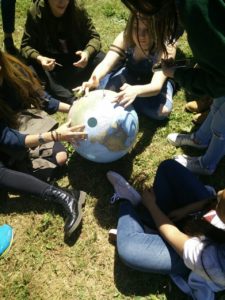According to the spirit of the “Let’s mak e room for science!” project, aimed at discovering the concepts of gravity, energy and light, the EPS Young Mind Section of Rome developed new activities concerning the same topics also in the last months of 2017. These activities were partially founded by the 2017 Activity Grant.
e room for science!” project, aimed at discovering the concepts of gravity, energy and light, the EPS Young Mind Section of Rome developed new activities concerning the same topics also in the last months of 2017. These activities were partially founded by the 2017 Activity Grant.
Thanks to the collaboration with the Physics Department of the University of Roma Tre, we started organizing guided observations of the Sun using the solar telescope of the Department. The observations were dedicated to children and young kids from local schools, but they also gave us the opportunity to involve undergraduate students of the Department, who immediately proved not only to be curious about the telescope, but also to be ready to tell themselves what they knew about the Sun to the younger children. During these observations, we also used little globes that could be oriented in order to simulate the illumination state of our Earth, so that participants could learn about the apparent motion of the Sun in the sky during the day, the seasons, equinoxes and time zones.
The concept of light was investigated also with a new exhibit: the “Colored shadows”. We started with three lightbulbs of red, green and blue light, aiming them all at a white screen. A pencil placed in front of the lights would then have not just one, grey shadow, but three and more colored shadows! Turning off one of the colored lights, it was then possible to notice how the color on the screen changed. This simple exhibit allows to deal with different concepts. First of all: the way in which our eyes are able to perceive colors (we have only three types of receptor called cones, that can see the red, green and blue light – from their combination, we are able to perceive millions of different colors). But then it is possible to talk about how the light travels in a straight line. And obviously, how the colors mix to form new shades.
The “Colored shadows” exhibit was used during the European Researcher’s Night 2017 at Roma Tre University. It drew the attention of lots of children who enjoyed watching their ever-changing shadows, but also the young students who were curious to discover the reasons why they were seeing those particular colors.
At the end, the “Let’s make fun with science: Sun, light and colored shadows” project had more than 300 participants between primary, secondary schools students and general public.
